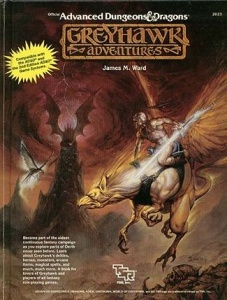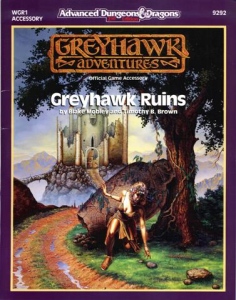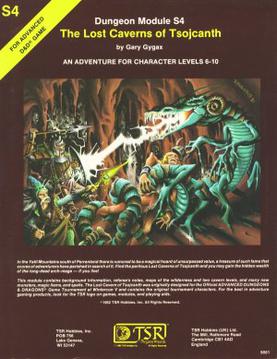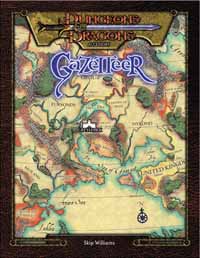The 1980 "Folio" edition
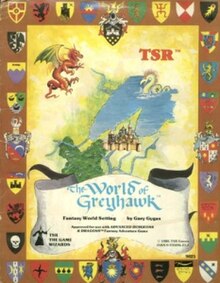
TSR intended to publish The World of Greyhawk early in 1979; the foreword by editor Allen Hammack was dated February 1979. Gygax himself assured Dragon readers in issue No. 37 that, barring catastrophe, the World of Greyhawk was ready for official release. [2] However, Gygax's The World of Greyhawk (TSR 9025) did not hit store shelves until August 1980. [2]
The World of Greyhawk consisted of a thirty-two page folio (this edition is often called the "World of Greyhawk folio" to distinguish it from later editions) [3] and a 34 in × 44 in (86 cm × 112 cm) two-piece color map of the Flanaess, by Darlene Pekul. [4] The book comes with a folder containing maps and a gazetteer which details all the states and regions found on the maps. [4] In addition to details of geography, history, and political states mentioned above, Gygax also included the following:
- names for the days of the week (Starday, Sunday, Moonday, Godsday, Waterday, Earthday, Freeday),
- names for the twelve 28-day months and the four 7-day festivals that made up the 360-day year (Needfest, Fireseek, Readying, Coldeven, Growfest, Planting, Flocktime, Wealsun, Richfest, Reaping, Goodmonth, Harvester, Brewfest, Patchwall, Ready'reat, and Sunsebb)
- notes on scale and movement, so the DM could keep track of how long it would take the players to move from region to region
- royal and noble precedence, so the DM could ensure the players addressed heads of state properly
- orders of knighthood, for players who desired to join one
- a glossary of runes and glyphs that the DM could use to create puzzling messages, mysterious omens and vaguely worded portents
The first edition covers less than a quarter of the landmass of Oerth, concentrating on the eastern part of the continent of Oerik, giving only the most basic descriptions of each state; DMs were expected to elaborate on these areas in order to make them an integral part of their own individual campaigns. [5]
The World of Greyhawk set describes a complete world for a Dungeon Master that is ready to use for campaign adventuring. [6] The map comes as two halves, with the Gazetteer booklet detailing the symbols on the map, and giving information on the monsters, peoples, geography, history, and government in the Greyhawk world. [6]
Reception
Elisabeth Barrington reviewed the supplement in The Space Gamer No. 33. [6] She commented that "When I first saw the module as it came in the mail, my reaction was, 'Good heavens!' I was struck by the beautiful artwork on the cover folder, bearing the arms of all the principal persons and organizations of the world. The map is even more beautiful, in full color, and everything is clearly marked and named. Everything is thought of for descriptions in the booklet; I doubt if most campaign worlds are this complete (mine certainly isn't)." [6] She continued: "Though the map would have been difficult to package in one piece, that would have made laying it out a bit easier. It is almost too large. We didn't have enough table space for it; it had to go on the wall or the floor. The book is printed in small type. It gives you a headache if you are trying to study some aspect of Greyhawk for any length of time." [6] Barrington concluded her review by saying, "This is an example of how to organize a world if you are a 'completeness' fanatic. Even if you don't use this particular world, it will help you get started on one of your own." [6]
The World of Greyhawk folio received two reviews in Dragon No. 46. In his review, Jeff Sieken was generally impressed, mentioning its colorful folder, the outside covers of which are "adorned with the numerous coats-of-arms of the various states, cities and factions chronicled within the gazetteer". [2] He said the two maps were "easily the highlight of the product", and that Darlene and the TSR art department "deserve to be congratulated for their quality", although he considered the sometimes dubious accuracy of the maps to be a major drawback. [2] He felt that reading the entire booklet would give one a pretty good understanding of the world depicted on the map, but he found that more information on some places would have been useful, and remarked on the lack of pantheon of Greyhawk-specific deities, as well as the lack of any details on the famous personalities of the world. [2] In Kenneth W. Burke's review, he remarked that he was glad to finally have "a universal constant" in the form of an official campaign setting. [7] Burke complained mostly about minor flaws in the work, but was particularly incensed about the use of the terms "cannibal" and "savages", assuming this was a derogatory reference directed at Africans. [7] Regardless, Burke rated the folio a 9 out of 10, blaming its problems on the product's size and scope. [7] Lawrence Schick, Vice President of Product Development at the time for TSR Hobbies, Inc., responded to the two reviews. He stated that the idea behind the product was "to provide a setting for a fantasy campaign, a coherent place where fantastic things could happen", and that although The World of Greyhawk was based on Gygax's own campaign, the publication "was made deliberately vague in many areas so that individual DMs could impress their own ideas and personalities upon it". [8] He also responded to Burke's charges: "As regards the savages, nowhere in the text of the Gazetteer is there any indication of anybody's skin color. Nobody here ever gave it any thought, because it doesn't matter." [8]
Game designer Jim Bambra found the original set "disappointing", because "there is only so much information you can cram into a 32-page booklet, particularly when covering such a large area". [5]
Schick, in his 1991 book Heroic Worlds, describes the campaign setting as "a medieval-Europe-type fantasy world where most of the early AD&D scenarios are set". [4]

